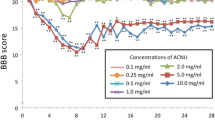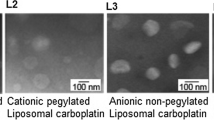Abstract
Expression of CD44 in glioma cells was previously correlated with tumor grade and is considered a stem cell marker. CD44 stabilizes the cystine–glutamate transporter (xCT) and inhibits apoptosis in cancer stem cells (CSCs). Recently it was found that Sulfasalazine (SSZ), an anti-inflammatory drug, acts as an inhibitor of xCT and therefore has potential as a targeted therapy for CSCs. In this study, we tested an efficacy of SSZ against glioma stem cell model developed in rats. As poor penetration of blood–brain barrier resulted in insufficient efficacy of systemic SSZ treatment, SSZ was delivered locally with convection-enhanced delivery (CED). In vitro, expression of CD44 in glioma cells and efficacy of SSZ against glioma cells and glioma stem cells were confirmed. SSZ demonstrated anti-proliferative activity in a dose dependent manner against these cells. This activity was partially reversible with the addition of antioxidant, N-acetyl-l-cysteine, to the medium. In vivo, CED successfully delivered SSZ into the rat brain parenchyma. When delivered at 5 mM concentration, which was the highest possible concentration when SSZ was dissolved in water, CED of SSZ resulted in almost no tissue damage. Against highly malignant bRiTs-G3 brain tumor xenografted rat model; the glioma stem cell model, CED of SSZ at 5 mM concentration induced apoptosis and prolonged survival. Consequently, CED of SSZ induced glioma stem cell death without evidence of tissue damage to normal brain parenchyma. This strategy may be a promising targeted treatment against glioma stem cells.





Similar content being viewed by others
References
Stupp R, Mason WP, van den Bent MJ, Weller M, Fisher B, Taphoorn MJ et al (2005) Radiotherapy plus concomitant and adjuvant temozolomide for glioblastoma. N Engl J Med 352:987–996
Hadjipanayis CG, Van Meir EG (2009) Tumor initiating cells in malignant gliomas: biology and implications for therapy. J Mol Med 87:363–374
Clarke MF, Dick JE, Dirks PB, Eaves CJ, Jamieson CH, Jones DL et al (2006) Cancer stem cells—perspectives on current status and future directions: AACR workshop on cancer stem cells. Cancer Res 66:9339–9344
Bonnet D, Dick JE (1997) Human acute myeloid leukemia is organized as a hierarchy that originates from a primitive hematopoietic cell. Nat Med 3:730–737
D’Amour KA, Gage FH (2002) Are somatic stem cells pluripotent or lineage-restricted? Nat Med 8:213–214
Morshead CM, Reynolds BA, Craig CG, McBurney MW, Staines WA, Morassutti D et al (1994) Neural stem cells in the adult mammalian forebrain: a relatively quiescent subpopulation of subependymal cells. Neuron 13:1071–1082
Reynolds BA, Weiss S (1996) Clonal and population analyses demonstrate that an EGF-responsive mammalian embryonic CNS precursor is a stem cell. Dev Biol 175:1–13
Anido J, Saez-Borderias A, Gonzalez-Junca A, Rodon L, Folch G, Carmona MA et al (2010) TGF-beta receptor inhibitors target the CD44(high)/Id1(high) glioma-initiating cell population in human glioblastoma. Cancer Cell 18:655–668
Phillips HS, Kharbanda S, Chen R, Forrest WF, Soriano RH, Wu TD et al (2006) Molecular subclasses of high-grade glioma predict prognosis, delineate a pattern of disease progression, and resemble stages in neurogenesis. Cancer Cell 9:157–173
Pietras A, Katz AM, Ekstrom EJ, Wee B, Halliday JJ, Pitter KL et al (2014) Osteopontin-CD44 signaling in the glioma perivascular niche enhances cancer stem cell phenotypes and promotes aggressive tumor growth. Cell Stem Cell 14:357–369
Ishimoto T, Nagano O, Yae T, Tamada M, Motohara T, Oshima H et al (2011) CD44 variant regulates redox status in cancer cells by stabilizing the xCT subunit of system xc(−) and thereby promotes tumor growth. Cancer Cell 19:387–400
Jijiwa M, Demir H, Gupta S, Leung C, Joshi K, Orozco N et al (2011) CD44v6 regulates growth of brain tumor stem cells partially through the AKT-mediated pathway. PLoS ONE 6:e24217
Yoshida T, Matsuda Y, Naito Z, Ishiwata T (2012) CD44 in human glioma correlates with histopathological grade and cell migration. Pathol Int 62:463–470
Chen RS, Song YM, Zhou ZY, Tong T, Li Y, Fu M et al (2009) Disruption of xCT inhibits cancer cell metastasis via the caveolin-1/beta-catenin pathway. Oncogene 28:599–609
Chung WJ, Lyons SA, Nelson GM, Hamza H, Gladson CL, Gillespie GY et al (2005) Inhibition of cystine uptake disrupts the growth of primary brain tumors. J Neurosci 25:7101–7110
Lo M, Wang YZ, Gout PW (2008) The x(c)− cystine/glutamate antiporter: a potential target for therapy of cancer and other diseases. J Cell Physiol 215:593–602
Narang VS, Pauletti GM, Gout PW, Buckley DJ, Buckley AR (2003) Suppression of cystine uptake by sulfasalazine inhibits proliferation of human mammary carcinoma cells. Anticancer Res 23:4571–4579
Robe PA, Martin DH, Nguyen-Khac MT, Artesi M, Deprez M, Albert A et al (2009) Early termination of ISRCTN45828668, a phase 1/2 prospective, randomized study of sulfasalazine for the treatment of progressing malignant gliomas in adults. BMC Cancer 9:372
Takeuchi S, Wada K, Nagatani K, Otani N, Osada H, Nawashiro H (2014) Sulfasalazine and temozolomide with radiation therapy for newly diagnosed glioblastoma. Neurol India 62:42–47
Liu X, Ding X, Deshmukh G, Liederer BM, Hop CE (2012) Use of the cassette-dosing approach to assess brain penetration in drug discovery. Drug Metab Dispos 40:963–969
Sampetrean O, Saga I, Nakanishi M, Sugihara E, Fukaya R, Onishi N et al (2011) Invasion precedes tumor mass formation in a malignant brain tumor model of genetically modified neural stem cells. Neoplasia 13:784–791
Sampetrean O, Saya H (2013) Characteristics of glioma stem cells. Brain Tumor Pathol 30:209–214
Bankiewicz KS, Eberling JL, Kohutnicka M, Jagust W, Pivirotto P, Bringas J et al (2000) Convection-enhanced delivery of AAV vector in parkinsonian monkeys; in vivo detection of gene expression and restoration of dopaminergic function using pro-drug approach. Exp Neurol 164:2–14
Saito R, Bringas JR, McKnight TR, Wendland MF, Mamot C, Drummond DC et al (2004) Distribution of liposomes into brain and rat brain tumor models by convection-enhanced delivery monitored with magnetic resonance imaging. Cancer Res 64:2572–2579
Hirst TC, Vesterinen HM, Sena ES, Egan KJ, Macleod MR, Whittle IR (2013) Systematic review and meta-analysis of temozolomide in animal models of glioma: was clinical efficacy predicted? Br J Cancer 108:64–71
Acknowledgements
This work was supported in part by Grants-in-Aid for Scientific Research from the Ministry of Education, Culture, Sports, Science and Technology in Japan (Grant No. #26293319 to R.S.). The authors would like to thank Enago (http://www.enago.jp) for the English language review.
Author information
Authors and Affiliations
Corresponding author
Ethics declarations
Conflict of interest
No author has a personal or institutional financial interest in the drugs, materials, or devices described in this paper.
Ethical approval
All animal protocols in this study were approved by the Institute for Animal Experimentation of Tohoku University Graduate School of Medicine.
Electronic supplementary material
Below is the link to the electronic supplementary material.
Rights and permissions
About this article
Cite this article
Haryu, S., Saito, R., Jia, W. et al. Convection-enhanced delivery of sulfasalazine prolongs survival in a glioma stem cell brain tumor model. J Neurooncol 136, 23–31 (2018). https://doi.org/10.1007/s11060-017-2621-7
Received:
Accepted:
Published:
Issue Date:
DOI: https://doi.org/10.1007/s11060-017-2621-7




